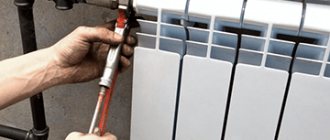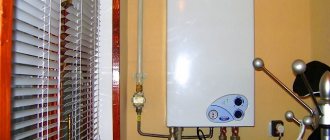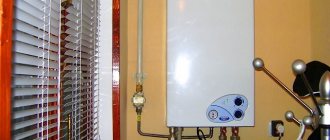Apartment buildings with central heating The desire to abandon central heating is increasingly visited by residents of apartments in apartment buildings. There are many reasons for this, but the main one is the high cost of utilities. At the same time, the quality of service and level of comfort in the house are not always what we would like. Let's look at how you can legally turn off central heating and create an autonomous system.
Note! In Russia and other countries, for example, Ukraine, the legal subtleties may differ, but technically the procedure will be approximately similar.
What the law says
The law does not prohibit residents of apartment buildings from refusing central heating services. But before shutting down the system, legal issues need to be resolved. The main nuance facing apartment owners who want to use modern autonomous systems lies in the features of the building's improvement.
In simple terms, the central heating system of an apartment building is a single network that has common risers, pipelines, fittings and heat meters. As a result, disconnecting one apartment from such a network leads to disruption of the system as a whole. In order to disconnect one unit, a fundamental reorganization and restructuring of the entire network is required.
The elements of the central heating system of a building are its property, and its composition is determined by the owners, management companies, etc. The issue of the possibility of abandoning central heating should be decided at a general meeting of residents if the property has been determined to belong to the house. This requirement is laid down in the Housing Code of the Russian Federation. In accordance with Art. 36, disconnecting one apartment from general communications leads to a reduction in the total property of the building. This requires serious reconstruction, so the issue cannot be resolved individually.
You cannot disconnect from general utility networks without permission, that is, without obtaining permission. Dismantling of heating elements and disconnecting an individual apartment from the water circuit should be carried out by specialists based on the decision made.
Required Documentation
In order to obtain permission and turn off the central heating supply, you must provide the following to the public utility authorities:
- application for disconnection;
- technical documentation of the apartment;
- confirmation of ownership of the apartment;
- consent of all residents living in the apartment (in writing);
- written confirmation for technical re-equipment of the apartment;
- technical project with all calculations (the project must be of high quality and well-designed, otherwise it will be rejected to prevent disruption of the functionality of the heating system of the entire house).
Then the same package of documents is transferred to the fire safety authorities. And only after all the work has been approved by the latter, the apartment owner can switch from central to autonomous heating.
If the utility service has decided in favor of the transition, an engineering team will be sent to the apartment to indicate the location and method of placing the batteries.
Date: September 25, 2022
When permission from other residents is not needed
There is no need to obtain owner permission if the elements of the central heating system have not previously been identified as common property of the building. In this case, the approval of other residents of the house is not required. Of course, even here we do not mean unauthorized shutdown. It will be necessary to obtain permission from organizations competent in this matter.
Any intervention in central engineering networks requires changes to the technical documentation. Section III of the technical passport of an apartment building must contain detailed data on heating systems. Any intervention in the system - dismantling radiators, installing additional equipment - requires mandatory changes to the technical passport, since the law defines such actions as reconstruction.
It is easier to turn off the heating if the residents of the entire house express such a desire. Then the procedure is carried out by reconstructing the general water circuit of the house. To implement such a project, the consent of the general meeting of homeowners and project documentation that has passed all the necessary approvals will be required.
Declaration of refusal
An application for refusal of services from a heat supply organization as a document does not have a unified form. Climatic conditions in the Russian Federation do not imply a complete abandonment of heat supply; we are usually talking about replacing central heating systems with local units. However, this procedure will already be considered reconstruction and redevelopment, therefore the form of the application is determined by the regulations in force in this area.
Form
The application form was approved by Decree of the Government of the Russian Federation dated April 28, 2005 No. 266 and is a form that contains all information about the object, its owners, attached documents, etc.
How to write correctly?
When making an application, you will need to enter the following information into the form:
- the name of the departmental committee of local authorities authorized to resolve issues of refurbishment of premises;
- personal and contact details of the applicant;
- information about the exact address of the redevelopment object and its owners;
- expected duration and mode of repair work;
- information about living adult household members with a note indicating the presence of notarized consent from each of them;
- listing of attached documents with details (if any) and the number of sheets occupied;
- date of filing and signature of the applicant.
Download application
After downloading, you can print it out and fill it out by hand, or enter the necessary information (except signature) on your computer, and only then print it out.
Package of documents
Housing Code of the Russian Federation
Art. 26 of the Housing Code states that any owner of an apartment in an apartment building has the right to disconnect from central utilities. To do this, a number of documents must be submitted to the approving authorities:
- Statement. You can write it in any form.
- Technical passport of the disconnected apartment.
- Title documents for housing.
- Consent of all adult residents living in the apartment in writing.
- Conclusion on the possibility of refurbishment.
This package of documents must be accompanied by a reconstruction project, which must be developed by specialists and also agreed upon with the relevant authorities.
Project
The reconstruction project is a serious technical documentation. It is impossible to draw up such a document yourself. It will be necessary to contact specialists. The basis for developing a reconstruction project are calculations showing the influence of the elements of the heating system located in the apartment being switched off on the functioning of communications as a whole.
In addition to this, the following is performed:
- Thermohydraulic calculations.
- Calculation of residual heating from risers and sunbeds.
If calculations show that it is technically possible to disconnect, the project can be submitted for approval. But if changes made to the communications of the house can have a negative impact on the level of thermal conditions in other apartments, the project most likely will not be approved.
Collective shutdown
Usually there is only one entrance at the elevator hub. If it has hot water connections, the elevator is not completely disconnected, but only from the heating system, while the valves are closed with plugs and sealed.
To correctly perform a collective shutdown, do the following:
- Organize a meeting of residents at which a decision on disconnection will be officially made and recorded in the minutes.
- Initiate the creation of a conciliation commission in the local administration and submit to it an application to disconnect the facility from the CSO, attaching the minutes of the residents’ meeting.
- If the application is approved, the commission must provide the representative of the residents' association with a list of organizations from which it is necessary to obtain technical conditions (TS) for the development of the project. Note that a positive decision is not at all mandatory: if the reorganization may negatively affect the work of the central distribution center or the gas supply system does not have sufficient capacity, the commission has the right to refuse it. The only way out in such a situation can be to re-equip the system, paid for by the residents, because of which the process has stalled.
- Next, you need to order a project from a design organization, to which all collected specifications are transferred.
The finished project must be approved by organizations servicing utility networks. Here is their list:
- heating network: checks whether the implementation of design solutions will lead to a deterioration in the operation of the heat supply system;
- gas facilities: makes sure that when connecting all the gas equipment provided for in the project, the gas supply system will not be overloaded;
- architectural management: the visa of this institution means that the installation of coaxial chimneys will not disturb the appearance of the architectural monument;
- housing organization: confirms the safety of the technical solutions proposed in the project in relation to load-bearing structures and the technical possibility of disconnecting the facility from the central heating system.
If the project also provides for electric heating, it should be approved by the energy sales office.
Then you need to enter into an agreement with a licensed construction and installation organization to carry out all the work provided for in the project. After checking the correctness of their implementation, representatives of all mentioned organizations must give permission for commissioning.
Difficulties
Heating radiators in an apartment
Legally disconnecting a house from the central heating system may seem simple at first glance, especially if we are not talking about a separate apartment, but about an entrance or the entire building. In practice, there are a number of difficulties. The main ones are related to Federal Law-190 “On Heat Supply”. In accordance with the provisions of this law, the transition to individual heating is prohibited, which often becomes the reason for refusal. However, it is still possible to obtain permission. The law does not prohibit the installation of individual boilers in apartments, but provides a list of them and requirements for them.
When obtaining permission for re-equipment, the type and type of boiler equipment is taken into account in the design documentation. As a result, if the project complies with the law, regulators generally will not deny redevelopment. In any case, when starting the procedure of disconnecting from central heating, you should not expect quick results. There are many difficulties in this issue. Since 2011, it has become almost impossible to disconnect one apartment from central communications.
Heating boilers
Sometimes giving up central heating in an apartment building is not as simple as it may initially seem. It is very difficult to obtain permission when switching to your own heating, due to the provisions of Federal Law-109 “On Heat Supply”. But this does not mean that you can completely forget about obtaining permission.
You can obtain permission by including in the draft documentation a clause on the installation of boiler equipment.
There are several types of heating boilers. Gas boilers are one of the options to make up for the lack of central heating in an apartment building. Using a gas boiler in an apartment instead of central heating, you can heat more than 200 m2 of space. In order for gas heating at home to function correctly, it is necessary to carry out installation work using the services of professionals.
Boilers for heating an apartment can be an excellent replacement for a standard battery for those who want to save money on services and get a more compact model of an automatic system. There are also electric boilers for heating apartments, which belong to modern heating systems. Here the task is to choose between a single-phase and three-phase boiler. By completing an electric boiler for heating an apartment, you can also save a lot on installation.
In addition to being economical, boilers are not much different from a conventional battery. The boiler can also be left unattended, it is silent, environmentally friendly and can be placed in any place that will be convenient for the inhabitants of the apartment. But in addition to everything, some types of boilers can also heat water in addition to heating.
Technical aspects of the issue
Having received the necessary permits, you can begin the technical implementation of the project. Dismantling of elements of the old heating system should only be carried out by specialists. Of course, you can cut the batteries yourself, but it’s better not to risk it. After dismantling the old system, all that remains is to install autonomous heating. In general, the implementation of such a project is no different from the installation of boiler equipment in country houses and cottages.
Despite the fact that such work, as a rule, does not cause difficulties, you should know a few nuances regarding the installation of heating systems specifically in apartments:
- To install autonomous heating in apartments, as a rule, wall-mounted boiler equipment is used. Such a boiler is located above the level of the radiators, so it is impossible to ensure natural circulation of coolant in the system.
- There are two ways to ensure forced circulation - by installing a circulation pump or a modern boiler, in the body of which all the necessary elements are already installed. These are pumping equipment, a safety group and an expansion tank. The second method is preferable.
- The type of boiler must comply with the law, that is, have a closed combustion chamber and automatic safety systems. The coolant temperature should be no more than 95 degrees, and the pressure in the system should be no more than 1 MPa.
- It is better to choose aluminum radiators for autonomous systems. They are not only reliable, but also have good heat dissipation. Plastic pipes are well suited for the piping system - they are inexpensive and easy to install.
- The wiring is selected based on the characteristics of the apartment. It is easier and cheaper to make a single-pipe Leningrad wiring with parallel connection of radiators. The optimal type of wiring from an operational point of view is radial, but it cannot always be implemented in apartments with low ceilings, since the floor will have to be raised.
Disconnecting batteries from central heating
When disconnecting an individual apartment from central utility networks, it is not always possible to completely redo the wiring. In most cases, it is not possible to shut off the riser, so only radiators can be disconnected from the circuit. This method of disconnection has its own nuances.
The apartment will still receive heat from the sun loungers and risers of the central system, and you will have to pay for it. The presence of common water circuit pipes in an apartment is always considered residual heating, and by law you must pay for it. This problem does not happen in houses where risers were originally installed in the entrance. In practice, such a water circuit does not occur very often.
Radiators can be connected with or without bypass. In the first case, the coolant will circulate through the bypass, which allows you to turn off some of the batteries. Such systems have proven themselves well with single-pipe wiring with parallel connection of radiators. After all, a reduction in the number of the latter leads to an increase in the temperature of the coolant in the system. Connecting batteries without using a bypass is actually a way to plug the circuit. This method can be used in risers.
Individual shutdown
Until recently, legislation clearly prohibited the disconnection of individual apartments from the CSO.
But in the new edition there is no direct ban.
This is what is said in paragraph 15 of Article 14 of Federal Law No. 190 “On Heat Supply”: “The transition to an individual heating scheme using heat sources, the list of which is determined by the current connection rules... excluding cases arising from the heat supply scheme,” is prohibited.
That is, the transition to “autonomy” is not prohibited at all, but only in the case of using “wrong” heat sources. What requirements must the “correct” equipment meet? You can find out about this from paragraph 44 of Resolution No. 307 of April 6, 2012. This is what this document prescribes:
- The combustion chamber of the boiler must be closed (combustion air is taken from outside).
- It is mandatory to have protection against overheating of the coolant and gas leakage in the event of spontaneous extinguishing of the burner.
- The coolant temperature should not rise above 95 degrees, and the pressure should not exceed 10 atm.
So, if the apartment owner uses equipment that meets the requirements of regulatory documents, the authorities no longer have the right to prohibit him from disconnecting from the central heating system and switching to individual heating. If they still refuse, this decision can be appealed in court.
To date, there are already several cases where residents in court managed to defend their right to install an autonomous (individual) heating system in their apartment.
However, you should be prepared for the fact that the local administration and the organization servicing the heating networks will do their best to prevent the owner of one apartment from intending to disconnect from the central heating system.
Autonomous heating in the apartment
There are good reasons for this:
- A multi-storey building is a single structure, and not a set of rooms isolated from each other. If a self-sufficient tenant, for reasons of economy or because he is away, switches his heating system to a low-temperature mode or turns it off altogether, the residents of neighboring apartments will freeze. But if this problem can still be solved by using electric heaters, then the appearance of condensation on a frozen ceiling cannot be prevented. Also, when setting an inadequately low temperature, the outer walls of the apartment itself with autonomous heating will freeze and become damp. And this will affect their service life, which will certainly be a problem for the entire house.
- Uneven heating of a building leads to undesirable processes in supporting structures, peeling of plaster, etc.
- There is no way to check whether the autonomous tenant has not unauthorizedly connected to the common heating circuit in order to use the heat supply for free.
This possibility cannot be completely excluded, since it is not possible to remove risers from a disconnected apartment.
Preparing a project for reconstruction
Modern apartments allow the use of many options for heating equipment, including underfloor heating and air heating systems. All technical nuances of the planned changes in connection with the transition to autonomous heating are reflected in the project, which is being developed by specialized organizations.
In order to order the preparation of a project, the homeowner must provide data on the layout of the apartment with the placement of furniture, the intended type and location of the heat generator and heating devices, information on the presence of heated floors.
Although each boiler installation project is different, it usually contains the following sections:
- general data with the main characteristics of the heating system;
- information about the location of the boiler and radiators;
- drawing routes indicating the diameter of the pipeline;
- type and brand of heating equipment.
When creating a project for installing individual heating using a heated floor system, the documentation mentions:
- floor thickness and design;
- pipeline diameter;
- plan showing boundaries and contours.
When preparing the project, hydraulic calculations and residual heating of risers and sunbeds are performed.
Example:
Project requirements
As already mentioned, in order to obtain approval and make the transition to autonomous heating, a technical project is provided to the utility service.
No one will give permission if the project does not meet the following requirements:
- the project shows the value of the living area where the battery is located in the heating system of the entire house;
- all changes must not contradict fire safety;
- the cost of the remaining equipment is calculated and the amounts to pay for the “remaining” heating are indicated;
- Calculations of switching efficiency are provided.
Therefore, a technical project cannot be drawn up independently without proper engineering education, since there is a high probability of non-compliance with the project requirements. As a result, the owner of the apartment will receive a refusal.
Important! In such cases, it is best to use the services of specialized organizations. . To obtain permission, the heating system refurbishment project is approved by the following organizations:
To obtain permission, the heating system refurbishment project is approved by the following organizations:
- energy supply company;
- heat supply company;
- gas service;
- housing and communal services authorities;
- architectural building protection company.
- Heating system requirements
In order to obtain permission, the owner of a residential premises must purchase autonomous heating equipment (in most cases, a wall-mounted boiler). It must meet all technical standards and ensure natural air circulation and must be located at a certain distance from heated devices.
Heating equipment must meet safety requirements: all necessary systems are automated, tightly closed outer box, pressure inside no more than 1 MPa. The advantage of such equipment, as is known, is temperature regulation: the highest mark on the scale is no higher than 95
Individual heating is chosen in order to save money. Therefore, it is recommended to use aluminum radiators due to their low cost and high heat output.
How to properly shut off a battery
The answer to the question of how to turn off the heating battery is extremely simple - just close one tap, leaving the second open. But which tap should you turn off?
As we understand, water is supplied to the heating riser from below.
Let's consider the options:
- The top tap is closed and the bottom tap is open. If repair work is carried out at the neighbors below or in the basement, or on the branch that supplies the house, the coolant will be drained and your radiator will be empty. If it is steel or cast iron, it will cause corrosion.
- The bottom tap is closed and the top tap is open. Regardless of any repairs, the radiator will be full.
So, we have learned how to shut off the battery for the summer season: to do this, close only the lower ball valve.
When cold weather sets in, watch for announcements at the entrance about the beginning of the heating season. Then close both ball valves so that no debris gets into the radiator - let it all pass through the bypass. In this case, there is no risk of battery rupture with the taps closed - in one or two days, sufficient pressure will not be able to form inside the radiator. During this time, the apartment will also not have time to freeze, especially since the room will be slightly heated from the riser.
How to turn on the radiator? There is nothing complicated about this - just open both ball valves and the coolant will begin to circulate normally through the switched on radiator.
On the first day of turning on the heating, when you hear the murmur of water in the system, do not rush to open the ball valves
The next day you can open them using the Mayevsky tap to release air. Attention! If you live on the top floor, you must have an air vent installed on your radiator. This will avoid the formation of air pockets due to which the heating device does not perform its functions.
Conclusion
Knowing how to close a radiator, you can decide how to prepare for the new heating season in the summer.
For this you will need:
- Ball Valves;
- bypass;
- air vent.
The work of installing bypass and ball valves must be done by professionals with the assistance of a plumber who will shut off the water in the riser. Please note that welding and related equipment will be required.
Emergency heating battery replacement
Ball valves and bypass are an option:
- ensure the safety of your batteries from corrosion and contamination;
- do not suffer from the heat during sudden warming during the heating season;
- ensure safety in the event of an emergency - if the radiator fails, it can be disconnected from the system, while the neighbors will not suffer from a flood or lack of heat;
- at any convenient time, replace the old radiator with a new one;
- Remove batteries for washing or painting.
- successfully use modern radiators with a thermostat without disturbing your neighbors.
A competent approach to organizing apartment heating is a concern for comfort and safety.
Video on the topic:
https://youtube.com/watch?v=PDCStRPzG8g











